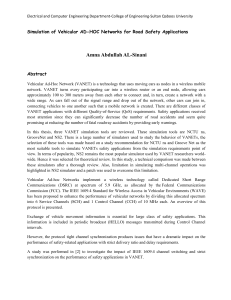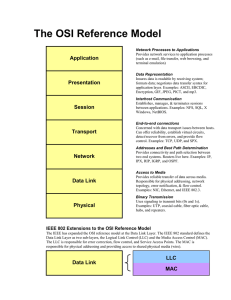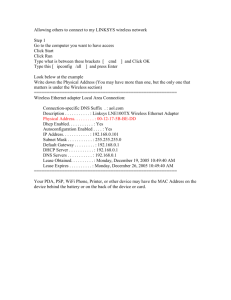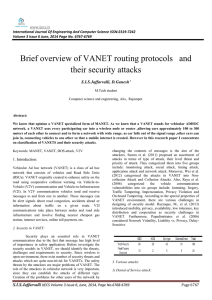International Journal of Application or Innovation in Engineering & Management... Web Site: www.ijaiem.org Email: Volume 3, Issue 5, May 2014
advertisement
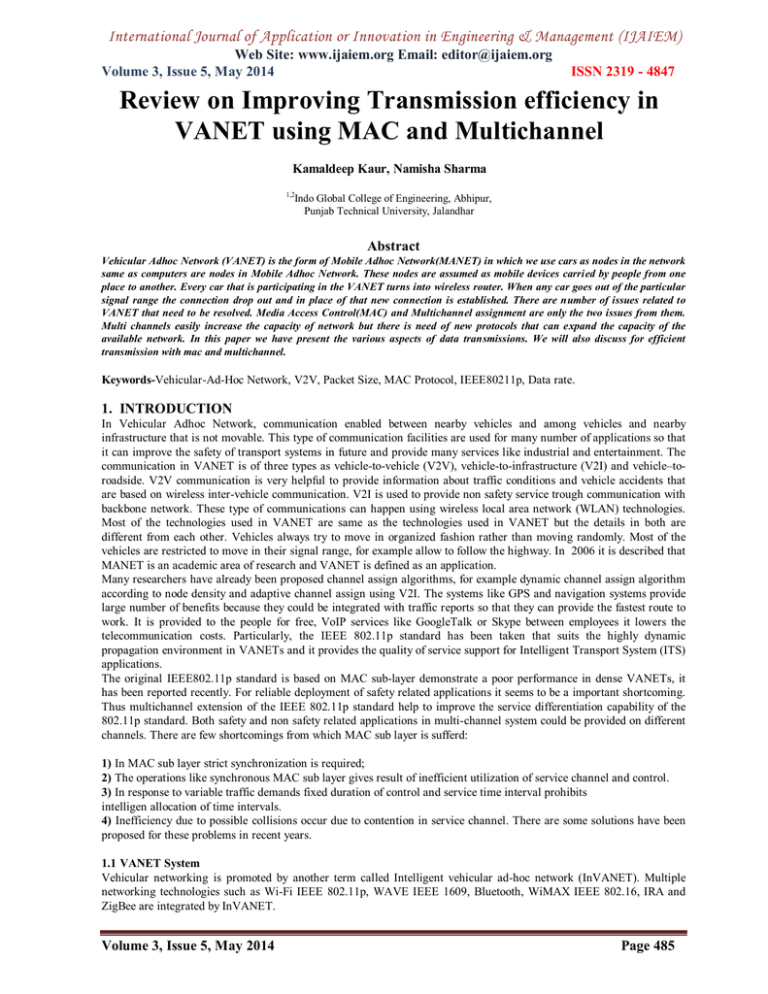
International Journal of Application or Innovation in Engineering & Management (IJAIEM) Web Site: www.ijaiem.org Email: editor@ijaiem.org Volume 3, Issue 5, May 2014 ISSN 2319 - 4847 Review on Improving Transmission efficiency in VANET using MAC and Multichannel Kamaldeep Kaur, Namisha Sharma 1,2 Indo Global College of Engineering, Abhipur, Punjab Technical University, Jalandhar Abstract Vehicular Adhoc Network (VANET) is the form of Mobile Adhoc Network(MANET) in which we use cars as nodes in the network same as computers are nodes in Mobile Adhoc Network. These nodes are assumed as mobile devices carried by people from one place to another. Every car that is participating in the VANET turns into wireless router. When any car goes out of the particular signal range the connection drop out and in place of that new connection is established. There are number of issues related to VANET that need to be resolved. Media Access Control(MAC) and Multichannel assignment are only the two issues from them. Multi channels easily increase the capacity of network but there is need of new protocols that can expand the capacity of the available network. In this paper we have present the various aspects of data transmissions. We will also discuss for efficient transmission with mac and multichannel. Keywords-Vehicular-Ad-Hoc Network, V2V, Packet Size, MAC Protocol, IEEE80211p, Data rate. 1. INTRODUCTION In Vehicular Adhoc Network, communication enabled between nearby vehicles and among vehicles and nearby infrastructure that is not movable. This type of communication facilities are used for many number of applications so that it can improve the safety of transport systems in future and provide many services like industrial and entertainment. The communication in VANET is of three types as vehicle-to-vehicle (V2V), vehicle-to-infrastructure (V2I) and vehicle–toroadside. V2V communication is very helpful to provide information about traffic conditions and vehicle accidents that are based on wireless inter-vehicle communication. V2I is used to provide non safety service trough communication with backbone network. These type of communications can happen using wireless local area network (WLAN) technologies. Most of the technologies used in VANET are same as the technologies used in VANET but the details in both are different from each other. Vehicles always try to move in organized fashion rather than moving randomly. Most of the vehicles are restricted to move in their signal range, for example allow to follow the highway. In 2006 it is described that MANET is an academic area of research and VANET is defined as an application. Many researchers have already been proposed channel assign algorithms, for example dynamic channel assign algorithm according to node density and adaptive channel assign using V2I. The systems like GPS and navigation systems provide large number of benefits because they could be integrated with traffic reports so that they can provide the fastest route to work. It is provided to the people for free, VoIP services like GoogleTalk or Skype between employees it lowers the telecommunication costs. Particularly, the IEEE 802.11p standard has been taken that suits the highly dynamic propagation environment in VANETs and it provides the quality of service support for Intelligent Transport System (ITS) applications. The original IEEE802.11p standard is based on MAC sub-layer demonstrate a poor performance in dense VANETs, it has been reported recently. For reliable deployment of safety related applications it seems to be a important shortcoming. Thus multichannel extension of the IEEE 802.11p standard help to improve the service differentiation capability of the 802.11p standard. Both safety and non safety related applications in multi-channel system could be provided on different channels. There are few shortcomings from which MAC sub layer is sufferd: 1) In MAC sub layer strict synchronization is required; 2) The operations like synchronous MAC sub layer gives result of inefficient utilization of service channel and control. 3) In response to variable traffic demands fixed duration of control and service time interval prohibits intelligen allocation of time intervals. 4) Inefficiency due to possible collisions occur due to contention in service channel. There are some solutions have been proposed for these problems in recent years. 1.1 VANET System Vehicular networking is promoted by another term called Intelligent vehicular ad-hoc network (InVANET). Multiple networking technologies such as Wi-Fi IEEE 802.11p, WAVE IEEE 1609, Bluetooth, WiMAX IEEE 802.16, IRA and ZigBee are integrated by InVANET. Volume 3, Issue 5, May 2014 Page 485 International Journal of Application or Innovation in Engineering & Management (IJAIEM) Web Site: www.ijaiem.org Email: editor@ijaiem.org Volume 3, Issue 5, May 2014 ISSN 2319 - 4847 In Vehicular ad hoc networks wireless technologies such as dedicated short-range communications (DSRC) are expected to implement which is a type of Wi-Fi. There are aome other candidate wireless technologies such as cellular, satellite, and WiMAX. Vehicular-ad-hoc networks is a component of the intelligent transportation systems (ITS). In ITS all the vehicles communicate via inter-vehicle communication (IVC) with each other and roadside-to-vehicle communication (RVC) help to communicate with roadside base stations. 1.2 Applications of VANET Applications of VANET are classified into two categories: i) Safety related: The main focus of safety related applications is of safety alerts to nearby vehicles. These applications are road condition warning, collision alert, deceleration alert etc. Internet connectivity related- In these applications the main focus is on the availability of high bandwidth stable internet connectivity. These applications are: web browsing, audio and video streaming, accessing emails etc. ii) Convenience: These type of applications are more importantly manage the traffic on the roads. iii) Other Applications: a. Safety b. Automatic parking c. Traffic signal d. Driver assistance e. Vision enhancement 2. RELATED RESEARCH [1] In 2013 “Measuring the Performance of Packet size and Data rate for Vehicular Ad Hoc Networks”, Chan-Ki Park, Si-Ho Cha described that Intelligent Transportation System has technology called Vehicular Ad-hoc Networks (VANETs). In Intelligent Transportation System standardize the Wireless access in Vehicle Environments (WAVE) that is based on IEEE802.11p and IEEE1609. WAVE provide information to driver and passenger and provide safety service. There are some resolution have already been proposed for high velocity and rapid topology change. It only related to packet size that would be equal. Due to this problem of limited data packet size various services could not be provided for VANETs. [2] In 2012 “Performance Analysis of Routing Protocols for Vehicular Delay-Tolerant Networks”, Joel J. P. C. Rodrigues Vasco N. G. J. Soares, described about simulation-based performance analysis study related to store-carry-andforward routing protocols for vehicular delay tolerant networks(VDTNs). In case of traffic load and time-to-live values eight routing protocols (Direct Delivery, First Contact, GeOpps, Epidemic, Binary and Source Spray and Wait, GeoSpray , and PRoPHET) are compared. With GeoSpray routing protocol we can make efficient use of network resources. [3] In 2012 “An IEEE 802.11p-Based Multichannel MAC Scheme With Channel Coordination for Vehicular Ad Hoc Networks”, Qing Wang, Supeng Leng, described about VANET that it implies apply multiple channels, such as control channel (CCH) and service channels (SCHs) so that it can provide open public road safety services and efficiency of driving. To dynamically adjust the length ratio between CCH and SCHs this paper proposes a variable CCH interval (VCI) multichannel medium access control (MAC) scheme. It reduces the transmission delay of service packets. [4] In 2013 “Performance Evaluation of IEEE 802.15.4 for V2V Communication in VANET”, Sishan Wang, Airong Huang, Tao Zhang described that in Vehicle to Vehicle(V2V) communication information about traffic conditions can be transmitted. In hardware IEEE 802.15.4-2006 which is complimant to 2.4GHz is used. Based on the experimental data Receiver Input Power(RIP), Packet Error Rate(PEP) and communication range are evaluated. [5] In 2010 “A Multicast Routing Scheme for Efficient Safety Message Dissemination in VANET”, Alvin Sebastian, Maolin Tang, Yanming Feng, and Mark Looi described about Cooperative Collision Warning System. This system is the safety application to provide situational awareness and warning to drivers by passing safety messages between the two or more cooperative vehicles. The routing strategies in CCWS are scoped broadcast for message dissemination. To reduce unnecessary transmission and also use adaptive transmission this paper presents a n efficient multicast routing scheme. This multicast routing problem can be transformed into delay-constrained minimum Steiner tree problem. This routing scheme can support various road traffic scenarios, and prioritize the receivers. [6] In 2013 “Context Aware Driver Behaviour Detection System in Intelligent Transportation Systems (ITS)”, Saif AlSultan, Ali H. Al-Bayatti decribed that VANET use Dadicated Short Range Communication (DSRC) so that vehicles have close proximity to communicate with each other. By applying Wireless access road safety can be improved and reduction in number of fatalities that are reason of road accidents. This paper mainly discuss the Context Aware System which will detect the novel and non-intrusive of driver and will warn the other vehicles to avoid accidents. In this system the dynamic behavior system capture the temporal and static aspects of driver. [7] In 2012 “An Energy Efficient Multi-channel MAC Protocol for wireless ad-hoc networks”, Duc Ngoc Minh Dang, Dang, Choong Seon Hong described about this that at the Physical Layer for wireless communications the IEEE 802.11 provide multi channels. Basically Medium Access Control (MAC) protocol only works for single channel. On different Volume 3, Issue 5, May 2014 Page 486 International Journal of Application or Innovation in Engineering & Management (IJAIEM) Web Site: www.ijaiem.org Email: editor@ijaiem.org Volume 3, Issue 5, May 2014 ISSN 2319 - 4847 channels there can be multiple transmission, if multiple channels can be used by multi-channel MAC protocol. To improve the reuse of wireless channels power control algorithm works fantastically. [8] In 2010 “An efficient dynamic adjusting MAC protocol for multichannel cognitive wireless networks”, Chih-Shun Hsu, Chih-En He described that wireless network named as the cognitive wireless network to enhance the usage of radio spectrum. This network allows users that are not licensed to use idle radio spectrum and scan it. For designing MAC protocols for cognitive wireless network there are some important issues such as avoid collisions and enhance the throughput of the network. For cognitive wireless networks this papers described dynamic adjusting MAC protocol. 3. PROPOSED WORK It is seen that with different transmission rates increase the efficiency in the data transfers but channel may get overloaded with different transmission requests, so to overcome this problem we need to implement multiple channels and Mac protocol. This will not only reduce the problem of channel overloading but also efficient data transfer. 4. CONCLUSION and FUTURE WORK From above survey it is observed that transmission plays a vital role for efficient data transfer. There are many open challenges needs to readdressed. Multi-Chanel assignment concept may help full and can transfer data with different transmission speed very effectively. In future we will implement the concept of multi-channels and Mac and analyze its results. REFERENCES [1] Chan-Ki Park, Si-Ho Cha, “Measuring the Performance of Packet size and Data rate for Vehicular Ad Hoc Networks” IEEE Conference Publications,2013 [2] Vasco N. G. J. Soares, Joel J. P. C. Rodrigues, “Performance Analysis of Routing Protocols for Vehicular Delay-Tolerant Networks”, 20th International Conference Publications, 2012 [3] Qing Wang, Supeng Leng, “An IEEE 802.11p-Based Multichannel MAC Scheme With Channel Coordination for Vehicular Ad Hoc Networks”, IEEE Transactions On Intelligent Transportation Syatems, Vol. 13, No. 2, JUNE 2012 [4] Sishan Wang, Airong Huang, Tao Zhang, “Performance Evaluation of IEEE 802.15.4 for V2V Communication in VANET”, International Conference on Computational and Information Sciences, 2013 [5] Alvin Sebastian, Maolin Tang, Yanming Feng, and Mark Looi, “A Multicast Routing Scheme for Efficient Safety Message Dissemination in VANET”, IEEE Conference Publications, 2010 [6] Saif Al-Sultan, Ali H. Al-Bayatti, “Context Aware Driver Behaviour Detection System in Intelligent Transportation Systems (ITS)” IEEE Transactions On Vehicular Technology, 2013 [7] Duc Ngoc Minh Dang, Choong Seon Hong, “An Energy Efficient Multi-channel MAC Protocol for wireless ad-hoc networks”, Global Communications Conference,2012 [8] Chih-Shun Hsu, Chih-En He, “An efficient dynamic adjusting MAC protocol for multichannel cognitive wireless networks”, IEEE International Conference, 2010 AUTHOR Kamaldeep Kaur is persuing M.Tech in Computer Science from Indo Global College of Engineering, Abhipur and received the B.Tech degree in Information Technology from Lovely Professional University Jalandhar in 2012. Her areas of interest are Computer Networks, DBMS. Volume 3, Issue 5, May 2014 Page 487
